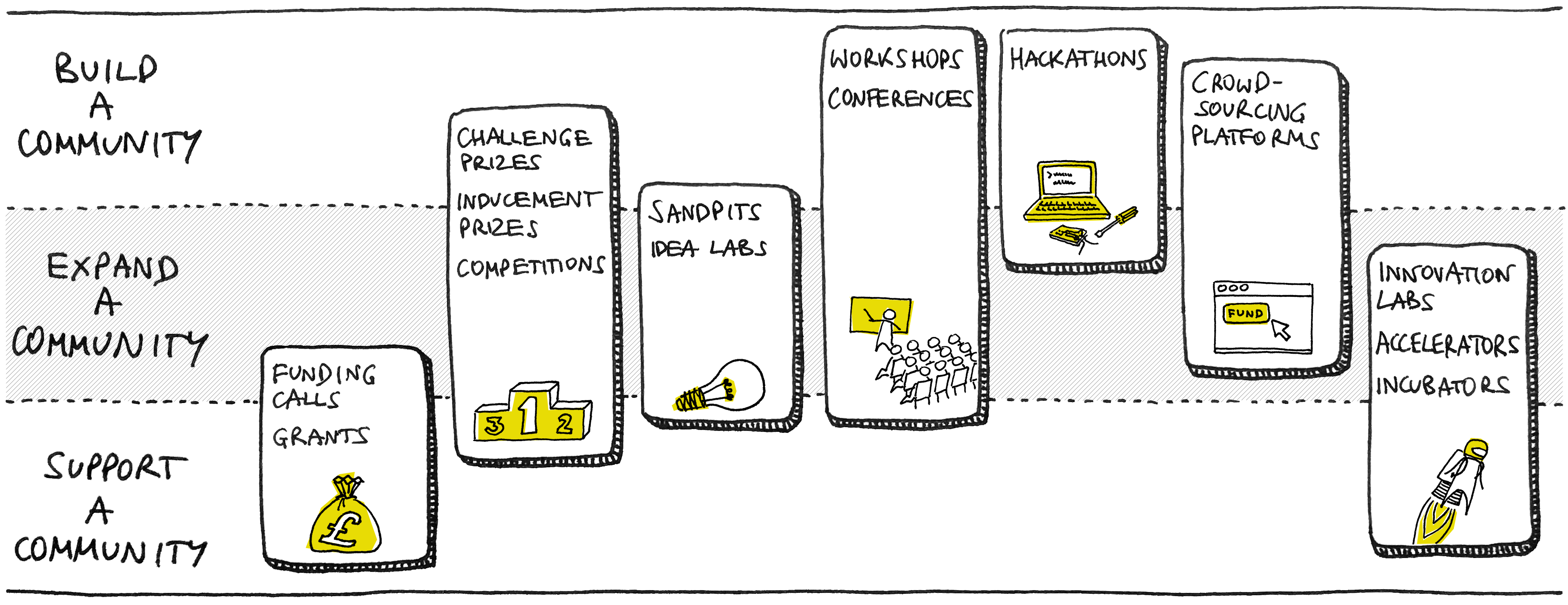
This blog post is part of a series on our Good Problems team. Each post looks at a different step in the process of designing a funding programme and makes suggestions about how to optimise to achieve a greater impact.
How do you bring problems and solvers together?
If you work at a funding organisation, this question should be familiar to you. Do you set up a funding call, launch a challenge prize or run a hackathon? Do you hold a workshop to familiarise people with the problem or use a crowdsourcing platform to reach a broad range of potential solvers?
In the first post of the series we talked about the advantages of identifying a good problem. In the second post we looked at the added value of understanding the skills, resources and motivations needed to solve the problem. This third and final post is about using this knowledge to design a suitable incentivisation approach.
There are many ways to incentivise problem-solving. Some more common than others. The suitability of each approach will depend on the problem and the community of solvers.
Challenges and Hackathons and Sandpits – Oh, my!
An incentivisation approach is a way of trying to motivate and support people to come up with solutions to a problem.
If people are not aware of the problem, they will need time to understand it and develop the motivation to work on solutions. If they are already working on solutions, they may need extra resources to achieve a breakthrough. That is why incentivisation approaches are so diverse. Here are a couple of examples:
-
Funding Calls / Grants: These are funding mechanisms that involve organisations offering financial support – and increasingly feedback and mentoring – to those interested in developing solutions to a specific problem. The problem can be defined either by the funder or the applicant (see the Humanitarian Innovation Fund’s open Core Grants or specific WASH funding calls).
-
Challenge prizes / Inducement prizes: These are prizes that offer a reward to the person or team who can first or most effectively meet a defined challenge. The prize can include a monetary reward, mentorship, or access to facilities and investors (see Nesta’s Challenge Prize Centre or InnoCentive).
-
Sandpits / Idea Labs: Sandpits (or Idea Labs in the US) are residential interactive workshops that bring together participants from across disciplines to work on addressing specific research challenges. The outcomes of a sandpit are not pre-determined, but are defined during the event (see EPSRC’s approach to designing sandpits).
-
Workshops / Conferences: These are a little bit different. While neither are funding mechanisms per se, they can help raise awareness of a problem and generate interest in solving it. Conferences tend to be larger and focused primarily on encouraging an exchange of ideas and forming new collaborations. Workshops can be more hands-on, with time allocated to working in groups to explore a problem and develop ideas (see our lessons from designing a workshop on Surface Water Drainage for the Humanitarian Innovation Fund).
-
Hackathons: Short and intense events where designers, developers, entrepreneurs and people with specific domain expertise collaborate on building projects that can help solve a defined problem (see Startup Weekend).
-
Crowdsourcing platforms: Online platforms where people can contribute with ideas, collaborate on projects, provide feedback and help shortlist top ideas to solve a problem (see OpenIdeo).
-
Innovation Labs / Accelerators / Incubators: Programmes designed to support entrepreneurs or teams develop their early-stage ideas into fully-fledged products and services that can solve problems. The support offered can include mentorship, money, co-working facilities, training, and access to potential partners and investors (see Bethnal Green Ventures or UNICEF Innovation Labs).
These approaches are not mutually exclusive, nor are they the only ones available. You can launch a funding call through a workshop or have the top ideas coming out of a crowdsourcing challenge attend an accelerator programme. The important thing is to choose an approach that matches the problem that you want to focus on.
Choosing an Incentivisation Approach
How do you know which approach to use and when?
In our previous post we outlined three roles a funding organisation can play – help build a community of solvers, expand it by bringing in new people and ideas, or support it by giving solvers relevant resources. Each of these roles will require a different incentivisation approach.
Here’s our interpretation of how the above incentivisation approaches map onto these three roles:

-
If a funder is looking to build a community of solvers, then workshops, hackathons, or crowdsourcing platforms can be relevant approaches. Although different in form and structure, these approaches are useful at drawing attention to little known problems or significant emerging ones, encouraging conversations around them and motivating people to work on solutions.
-
If the aim is to expand a community of solvers, funders can explore the possibility of setting up challenge prizes, sandpits, workshops, or make use of crowdsourcing platforms. Core to these approaches is encouraging collaborations between people or teams with different backgrounds and skills. Their aim is to bring on board new perspectives or domains of expertise that can challenge held expectations and provoke new ways of thinking.
-
If a funder is looking to support a community of solvers, approaches like funding calls, innovation labs, incubators or accelerators can help them achieve this goal. These approaches focus on offering wide ranging support to problem-solvers such as funding, mentorship, access to facilities, users and investors, as well as partnerships or contracts.
Having a rough idea of what your funding organisation needs to incentivise – whether it’s building, expanding, or supporting a community of solvers – represents an important starting point to designing an approach that can have a genuine impact.
It’s also useful to know that the boundaries between these approaches are very loose. It is often the case that in the process of ‘choosing’ a suitable approach you end up creating a new format – one that is tailored to the problem and its solvers.
Adapting the Approach
Any incentivisation approach you choose will need to be adapted. This is where knowledge about the problem and the community of solvers comes in.
The motivations of solvers, their available resources and the level of risk they’re willing to take should all shape the approach.
For example, if you’re designing a challenge prize, this information can help you define the criteria for a winning solution or the size of the reward. If you’re designing a crowdsourcing call, it can help you understand how to best articulate the problem to ensure a broad reach and diverse response. For a workshop, it can help you define the goals of the event and identify key attendees who need to be part of the conversation.
Each incentivisation approach will have its own defining features. The design of these features should reflect the problem, as well as the needs of its solvers.
In the end, an incentivisation approach is not just a way of flagging up a problem that needs to be solved. It’s about creating an engaged and adequately resourced community around that problem.
Refining the Approach
After creating an initial version of the approach, it’s time to test it with potential solvers. The aim of this step is to find out whether the approach is appealing, supportive and relevant.
-
Appealing: Is the approach engaging and motivating? Is it likely to attract the people and collaborations needed to build impactful solutions?
-
Supportive: Does it offer problem-solvers the necessary support to start developing impactful solutions? Is it inclusive and accessible to those who could add value to this process?
-
Relevant: Will this approach and the resulting ideas actually help solve the problem?
A quick way to figure out the above is to ask likely participants: ‘Would you take part in this?’. If the answer is ‘No’, understand why not and keep iterating the approach until the answer is ‘Yes! Where do I sign up?’.
Closing note: Designing for Impact
Measuring and demonstrating the impact of a funding programme is never going to be an easy or clear cut process. But being open, transparent and deliberate about the process of designing such a programme can help maximise its potential for impact. To support this claim, we highlighted three areas where funders should focus their efforts:
-
Identify a good problem. Focus on problems that are real, worthwhile, timely, engaging and suitable for your organisation to prioritise.
-
Understand the skills and collaborations needed to come up with constructive ideas. Understand who are the people and communities able to work on solutions, what motivates them and what might limit their involvement. This will help you define your role in this process – are you building, expanding or supporting a community of solvers?
-
Design an incentivisation approach that motivates and supports people to build solutions. This is not just about choosing an approach that best meets a set of criteria, but about building an environment where people can think in different ways and explore new ideas and collaborations.
We introduced the above as three separate phases. In practice, they’re most likely to occur in parallel and shape and inform each other. For instance, it’s not unusual to have clients ask us to find good problems that can be solved through a specific incentivisation approach or in a given timeframe. ‘The problem’ may not always be the starting point for the design of funding programme, but it is a core component.
The aim of this series is to encourage funding organisations to design programmes that address real problems and actively engage with solvers as part of this process. Organisations able to deliver such considerate funding programmes are not only improving the likelihood of getting problems solved, but they are also creating a community of solvers who are motivated, engaged and feel part of a valuable and impactful process.

